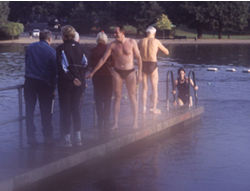Cross Training: A Programme
By Charles Doxat
Charles Doxat was county swimming champion in the early 1960s, and went to be many times British Age Group swimming Champion and record-holder. He won 7 British Age-Group Triathlon Championships in the 1990s (at Half Ironman, Olympic and Sprint distances).
Introduction

Please refer to Cross-Training – guidelines. As you will also know from the last article we have sensibly chosen to train for no more than 7 hour per week. Training that is. Not changing, showering, chatting. But it does include rest intervals!
Maximise improvement
The most obvious point for a long-time competitive runner/ swimmer/ cyclist/ oarsman (delete as necessary) is that the room for improvement in your no. 1 discipline is likely to be small (if not, why haven’t you already achieved it?), whilst your capacity for improvement in the new ones is likely to be massive. However, cross-training can also get you a 5 to 20 year best ever (depending on age of athlete) in your no. 1 event, but more importantly give you more pleasure getting there.
It’s essential to work hardest on your weakest disciplines, and don’t forget we’re going to reduce the time spent on your no. 1 discipline (running?) by at least 50%, but without it leading to any deterioration in performance.
Variety
Split the year into four 3-month periods and plan accordingly, depending on your chosen events. In my case it reads:-
Jan-Mar
Distance/strength
Apr-Jun
Increase ration anaerobic:aerobic
Jul-Sept
All interval work except 1 or 2 sessions per week
Oct-Dec
Unwind: fun, try new ideas
Within your ‘broadstroke’ plan work out the sessions appropriate to each period, including a selection of weekday sessions to be rotated, plus weekend sessions which, for most people, can be longer. Be disciplined in what you plan and do, but retain flexibility. You’re old enough to know if you don’t feel ‘right’, in which case cut down or cancel the session and make it up another time. Here is a sample week for the Jan-March period. I’ve deliberately excluded the detail which will vary greatly depending on individual ability.
Here is a sample week for the Jan-March period. I’ve deliberately excluded the detail which will vary greatly depending on individual ability.
| Day | Discipline and Approximate Time | Type | ||
| Monday | Swimming 40mins | Long intervals (400m) or continuous | ||
| Tuesday | Row/cycle/weights (in gym) 60mins | Continuous. Row 15mins; Cycle 30mins (building); weights 15mins | ||
| Wednesday |
Swimming 40mins Run 45mins |
What you didn’t do on Monday
Continuous |
||
| Thursday | Row/cycle/weights (in gym) 60mins | Continuous. Row 15mins; Cycle 30mins (building); weights 15mins | ||
| Friday | Day off or make up shortfall from earlier in the week | |||
| Saturday |
Swimming 40mins Run 45mins |
Stroke work | ||
| Sunday |
Run or cycle 1.5hrs continuous |
Alternate |
Two important aspects are:
- That where possible (e.g. Tuesday and Thursday), sessions should be continuous (i.e. move straight from ergonometer to ‘lifecycle’).
- The balance between disciplines should change week-to-week in a particular direction, always remembering that as a discipline receives less time it receives more concentrated effort.
Now is the time for experimentation prior to laying down your plans for the year. If swimming is to be included but your technique is dubious, get some professional help. Also you may find that it is necessary to join a Swimming Club (with a masters group) to get bath-time and proper training.
Make sure your plan is within your capacity. If necessary start with a relatively easy schedule and increase it. There’s nothing worse than struggling to complete the very first session you’ve set yourself.
Please record your plans and each training session in a notebook or log-book. This is a valuable discipline which can be an additional motivation in its own right. If you’re honest with yourself and work hard, I’m certain you’ll not only have more enjoyment, increase your performance on your ‘new disciplines’ amazingly, but also set at least best-for-five-years performance in your main event.
Two other issues
Heart rate monitors
Many athletes (especially triathletes) are training (and competing) by a heart rate monitor (HRM) more than a stop watch. Being a Luddite I don’t like them; they frighten me. But borrow one from a friend or at a training camp and see how you get on. Lots of excellent age-groupers swear by them. Please ensure your anaerobic threshold heart-rate is accurately assessed first.
Alcohol
In a word: yes. Fortunately the Government Health Officer has recently increased the recommended maximum for males to 35 units per week. Which is just about a bottle of wine a day. The only thing I avoid like the plague is drinking before training as it makes my stomach burn. That’s why I much prefer training in the morning!
So there you have it folks! 1 hour a day training plus a bottle of vin ordinaire – the recipe for better performances.
This article was written in 1995.
